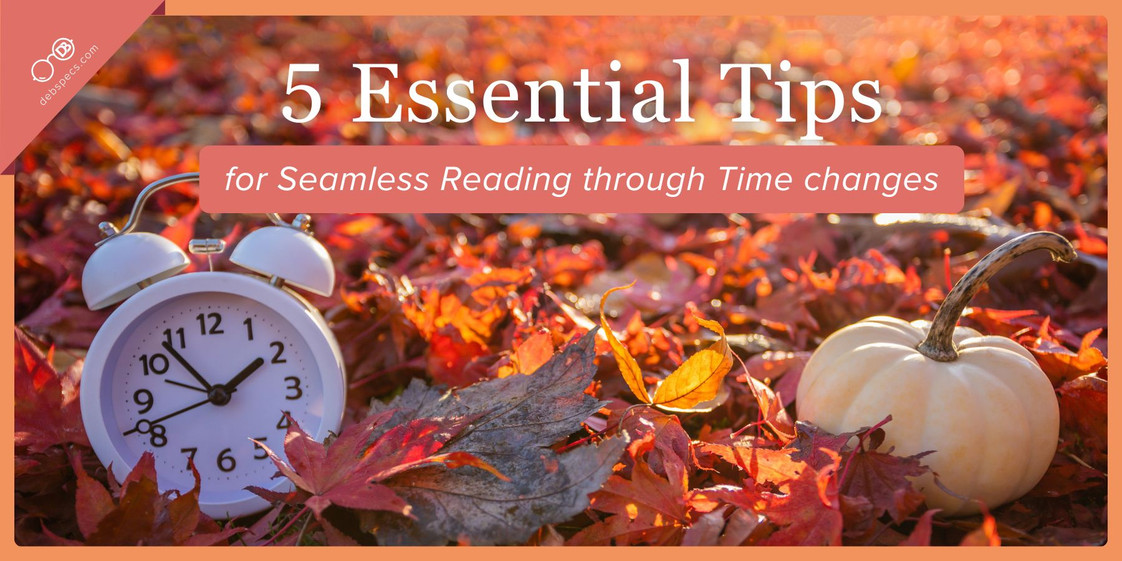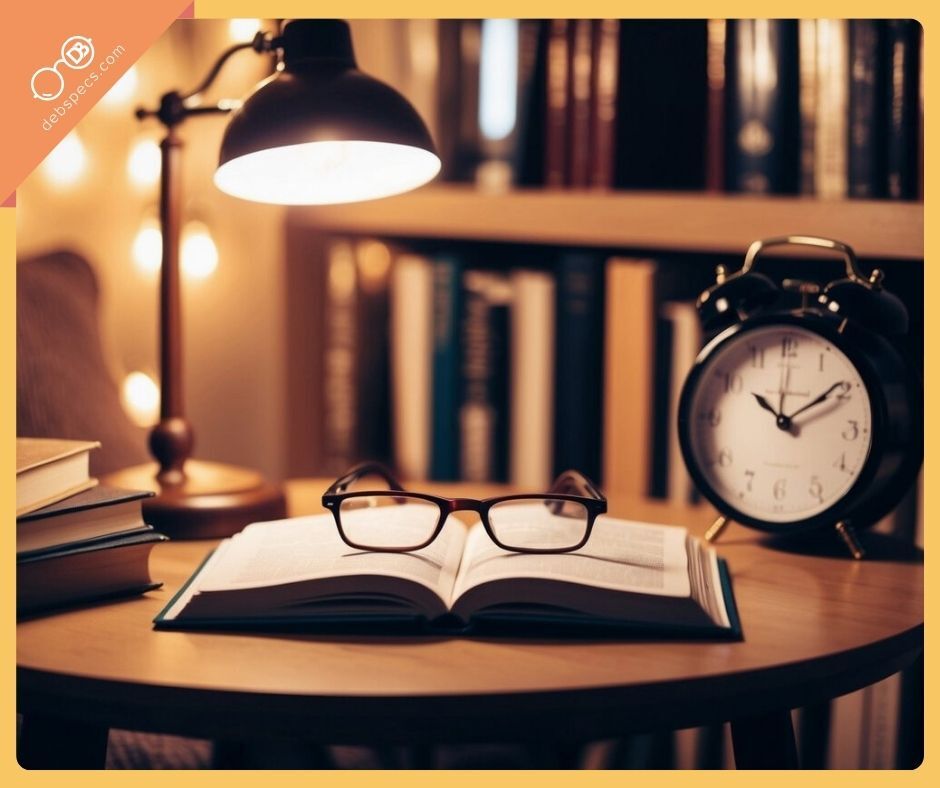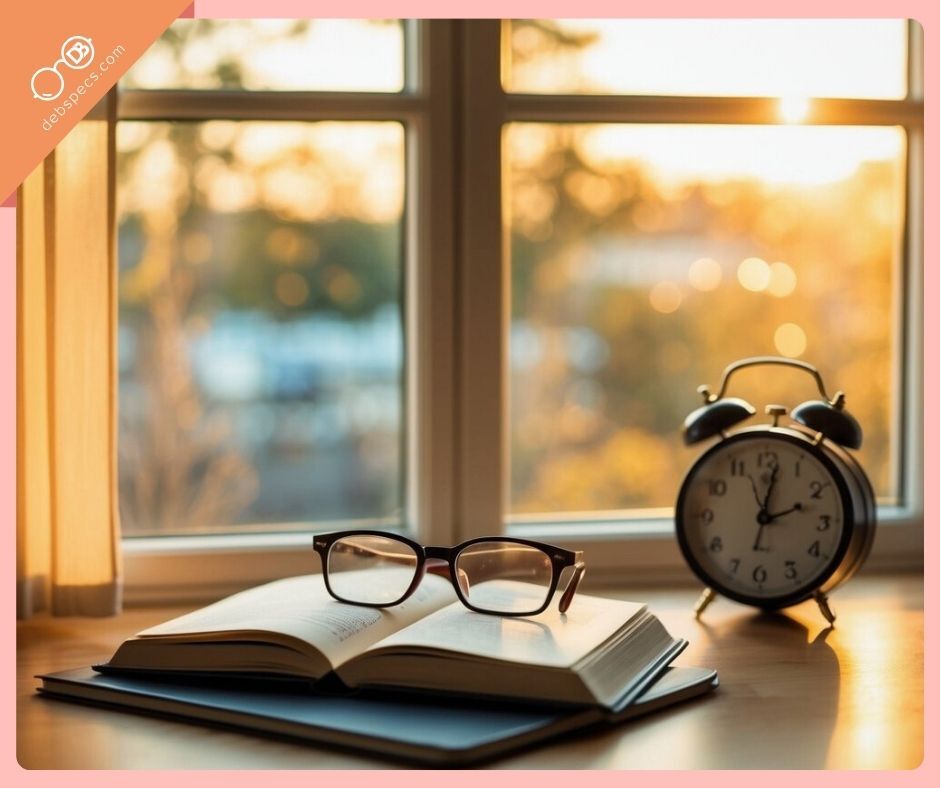
5 Essential Tips for Seamless Reading Through Time Changes
Posted by Team Debby on 13th Oct 2024
As Daylight Saving Time winds down, our evenings grow darker earlier—and that can change how (and when) we read. Shorter days often mean shifting routines, adjusting lighting, and relying more on the right eyewear to keep reading comfortable.
This guide walks you through practical steps for adapting your reading habits, protecting your eyes, and making the most of cozy fall and winter nights with a good book.

What Is Daylight Saving Time?
Daylight Saving Time (DST) is when clocks shift forward in spring and back in fall. It was first introduced during World War I to save energy by extending evening daylight.
- U.S. Schedule: Starts the second Sunday in March, ends the first Sunday in November
- EU Schedule: Starts the last Sunday in March, ends the last Sunday in October
- Exceptions: Hawaii, most of Arizona, and several countries don’t observe DST at all
While the original goal was energy conservation, modern studies debate whether it still makes a big difference. What we do know: the time change can affect our sleep and focus.

Keeping Your Vision Steady Through Shifting Light
As the article explains, time changes can subtly affect how your eyes adapt to new lighting patterns and reading routines. Readers designed for clarity and reduced strain can help maintain visual comfort as your schedule adjusts, making transitions feel smoother on your eyes. The options below reflect how thoughtful lens design can support consistent, comfortable reading through these shifts.
How the Time Shift Affects Your Body
Your body’s internal clock—called the circadian rhythm—relies on natural light cues. When DST ends and evenings get darker sooner:
- Sleep patterns can feel “off” for a week or two
- You may feel more tired in the evenings
- Reading focus and comprehension may dip temporarily
Tip: Adjust bedtime gradually in 15–30 minute steps a few days before the clock change. Getting natural morning light also helps reset your rhythm.

Adjusting Reading Habits for Shorter Days
To keep reading enjoyable (and eye-friendly) when the evenings darken earlier:
- Shift your reading schedule
- Try moving reading sessions earlier in the day to catch natural light.
- Morning reading pairs well with fresh focus and stronger comprehension.
- Upgrade your lighting
- Use warm-toned LED bulbs for cozy, glare-free illumination.
- Position lamps behind or beside you to reduce shadows on pages.
- Adjustable reading lamps let you fine-tune brightness for comfort.

Choosing Eyewear for Evening Reading
The right glasses can make darker evenings feel effortless on your eyes. Two top upgrades:
- Anti-Reflective Lenses
- Cut glare from lamps and screens.
- Improve clarity in low light.
- Reduce squinting and eye fatigue.
- Blue Light Filtering Glasses
- Protect eyes from digital glare when reading on screens.
- Help prevent evening screen time from disrupting sleep.
- Especially useful if you spend long hours on tablets, e-readers, or laptops.
At DebbySpecs, we carry both options in stylish, budget-friendly frames—so you don’t have to choose between fashion and function.

Creating a Cozy Reading Environment
Your space matters just as much as your glasses. To set up a stress-free reading nook:
- Organize your space: Keep clutter away and essentials (books, glasses, lamp) close at hand.
- Stay ergonomic: Choose a supportive chair and hold books at eye level.
- Mind your posture: Avoid leaning too close or bending your neck for long stretches.
Small adjustments in setup go a long way in keeping your eyes and body comfortable.

Eye-Friendly Reading Habits
Even the best eyewear benefits from smart reading routines:
- Follow the 20-20-20 rule: Every 20 minutes, look at something 20 feet away for 20 seconds.
- Blink often: Prevents dryness when focusing on pages or screens.
- Try eye exercises: Gentle rolls, palming (cupping warm hands over closed eyes), and regular breaks refresh your vision.
- Snack smart: Water, nuts, or fruit can keep your focus sharp longer.

Myths vs Facts About Reading in Low Light
Myth: Reading in dim light will permanently damage your eyes.
Fact: Low light won’t cause lasting harm, but it can strain your eyes, leading to fatigue and headaches.
Myth: Any lamp works for reading.
Fact: Bright, well-positioned, warm-toned lighting makes reading clearer and more comfortable.
TL;DR (Quick Summary)
- When Daylight Saving ends, evenings get darker sooner, making lighting and eyewear more important.
- Adjust your reading schedule, add warm-toned LED lamps, and keep a clutter-free, ergonomic setup.
- Anti-reflective and blue light glasses reduce strain during extended evening reading.
- Use eye-friendly habits like the 20-20-20 rule, blinking, and taking breaks to maintain comfort.
FAQs About Reading After Daylight Saving Ends
Q: Will the time change permanently harm my sleep?
A: No. Most people adjust within a week or two, especially if they get morning light and maintain consistent bedtime routines.
Q: Do I really need special reading glasses for evenings?
A: While not essential for everyone, anti-reflective or blue light lenses can make reading clearer and more comfortable—especially under artificial light or on screens.
Q: What’s the best type of lightbulb for reading?
A: Warm-toned LED bulbs are energy efficient, reduce glare, and provide steady light without harsh brightness.
Q: Can snacks and hydration really help with concentration?
A: Yes! Dehydration and low blood sugar can reduce focus. Water, nuts, or fruit keep your energy stable during long reading sessions.
At DebbySpecs, we believe clear vision should never come at the cost of style. As the nights get longer, a little planning (and the right pair of readers) keeps your evenings cozy, sharp, and stylish.
See Clearly. Look Stylish. Always.

